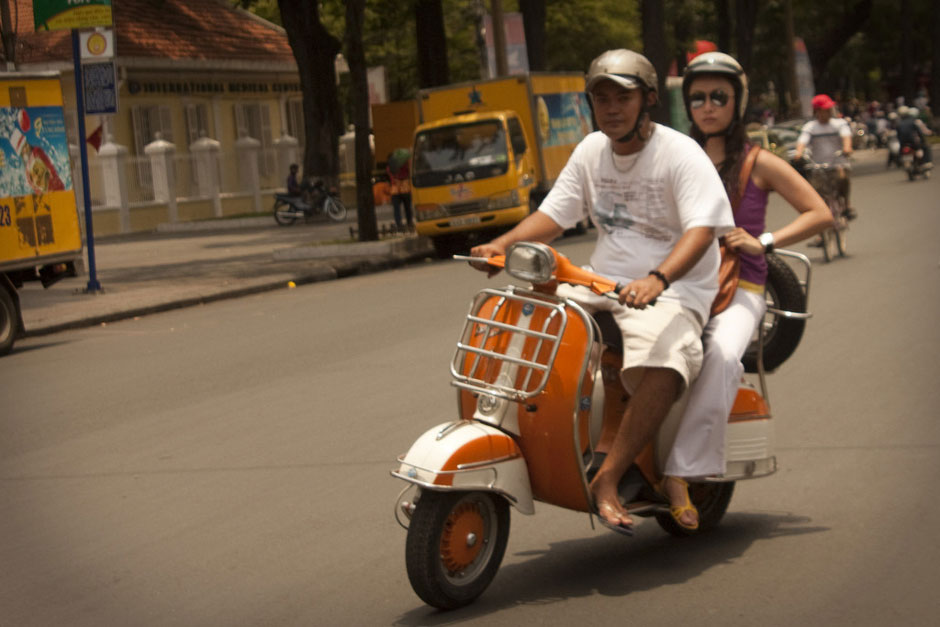 |
Day 1 - Ho Chi Minh City Arrival
Your guide will greet you upon arrival and transfer you by private car through the city to your hotel for check-in.
Overnight in Ho Chi Minh City.
Day 2 - Ho Chi Minh City (B,L,D)
This morning you’ll visit a local home to learn how true Saigonese live and cook. Start early at a suburban Ho Chi Minh City market (whilst it’s still busy) with your host who is more than happy to show you around their local neighbourhood and share some of their favourite dishes. You’ll then head back to the house to start your cooking, which you’ll eventually devour for lunch! A selection of dishes can be chosen from a menu, so see (in advance) what tickles your fancy.
Note: If the group size exceeds 10 people, the cooking class will be separated into another family home. After, return to the centre of Ho Chi Minh City.
This afternoon visit Vietnam"s first traditional medicine museum, the FITO Museum, which displays an amazing collection of 3,000 items relevant to the development of traditional Vietnamese medicine (which dates as far back as the Stone Age). Implements used to prepare indigenous herbs, objects commonly found in traditional pharmacies, ancient books and documents on traditional Vietnamese medicine can be seen in the galleries.
At the end of the day, watch a traditional music show in a private home where participation is always welcome! Stop by the famous Fanny’s ice cream parlor for a refreshing snack before returning to your hotel late this afternoon to relax.
Dine at the stunningly restored Temple Club, the opulence will take you back to 1930’s Indochina.
Overnight in Ho Chi Minh City.
Day 3 - Ho Chi Minh City (B)
There are many ways to explore the bustling city of Ho Chi Minh (still called Saigon by the locals). However nothing is as exhilarating as a ride on a chauffeur-driven Vespa scooter!
This morning, head to Tao Dan Park to catch the bird lovers club (morning only, 0600 – 0900). Enjoy a local coffee while your tour guide explains about the history and practice of keeping birds in Saigon.
The next stop is the monument of Thich Quang Duc, a Vietnamese Mahayana Buddhist monk who burned himself to death on June 11, 1963 to protest against the persecution of Buddhists by South Vietnam’s Ngo Dinh Diem administration.
Then take a quick stop at the colorful Ho Thi Ky flower market before riding to the Funeral Home to get to know about Vietnamese funeral ceremonies & customs.
Rollthrough China town to Nhi Phu temple built in the end of 17th century by Chinese immigrants from Fukkien Province. Although the exact construction date is unknown, an inscription on the pagoda"s ancient bell dates the pagoda to pre-1765. Nhi Phu Temple is built in a “Kh?u” (gate) architectural style with an open yard in the center. Its roof is covered with tubular tiles lined with bas-relief mosaics made from broken ceramics, depicting the eight immortals of Taoism including apricot trees, orchids, bamboo and of course dragons and phoenix.
Continue with a short walk through the alley full of tailor’s supplies. Then back to Nhi Phu temple to return to district one by bike. On the way stop at a Chinese Medicine shops for an explanation about “Thu?c B?c - medicine from herbs” or ”Thu?c tàu – medicine from China.”
Leaving China town, drive through the tunnel to District Two where to see downtown Saigon from a different perspective and have a chance to see a developing Ho Chi Minh City.
Visit a local market before heading back to District 1 for a twin set of neighboring landmarks: the architecturally interesting Post Office and the map of Saigon that shows where this modern city has come from, followed by the Cathedral of Notre Dame (“Our Lady”).
Move to the remarkable Reunification Palace and the previous CIA Office before a drive down Dong Khoi Street (it means “people’s revolution”) to reveal the place wherein 1975 during the dying days of the former regime, the iconic photograph was taken of a helicopter lifting people out of Saigon.
A stop at the historic Opera House (now the Municipal Theatre) to talk about the history of the square from the time it was the main road into the Bat Quay, to the French invasion, to the filming of Phil Noyce’s “The Quiet American”.
The final stop is an outside view of HCM City People’s Committee (formerly Hôtel de Ville) which is one of the most photographed buildings in Vietnam - notable for its gardens, ornate facade and elegant interior lit with crystal chandeliers.
End the tour at the hotel.
This afternoon step off the beaten track and take a stroll to the oldest quarter of the city (car at your disposal should you need it). Explore Saigon’s well-kept secret - Antiques Street (Le Cong Kieu), where genuine antiques are mixed in with genuine fakes: Aladdin oil lamps, carved wooden chests, Marelli copper fans, opium pipes, abacuses, etc. You can also find military cast-offs from the Vietnam War, and if you look hard enough, relics from the French Indochina era. Follow a typical street to reach the Beaux-Arts Museum, a superb neo-colonial building home to various modern arts. Explore the art galleries surrounding the museum, where local artists gladly display their talent.
The rest of the day and evening at leisure.
Overnight in Ho Chi Minh City.
Day 4 - Ho Chi Minh Departure (B)
Full day at leisure until you transfer to the airport for your next destination.
 |



